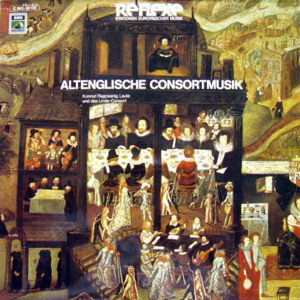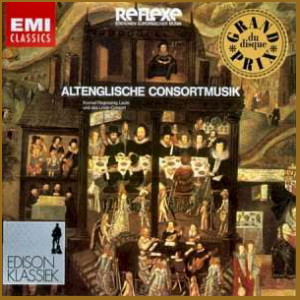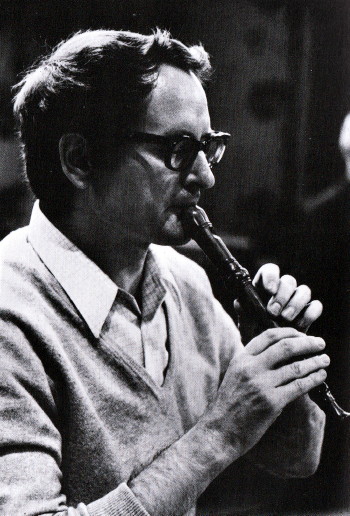 |
1 LP -
1C 063-30 105 - (p) 1972
|

|
| 1 CD - 8
26471 2 - (c) 2000 |
|
ALTENGLISCHE CONSORTMUSIK
|
|
|
|
|
|
Nicholas
Strogers ? (16.-17. Jhdt.)
|
|
|
Aus
"The first book of concert lessons"
(Thomas Morley)
|
|
|
| - In Nomine
Pavin - Violine,
Blockflöte, Viola da gamba, Laute,
Cittern, Pandora |
3' 36" |
|
William Byrd ?
(1543-1623)
|
|
|
- My Lord of
Oxenfords maske - Violine,
Blockflöte, Viola da gamba, Laute,
Cittern, Pandora
|
0' 58" |
|
| Richard
Allison (16.-17. Jhdt.) |
|
|
- Goe from my
window - Violine, Blockflöte, Viola
da gamba, Laute, Cittern, Pandora
|
4' 06" |
|
| Anthonz
Holborne (17. Jhdt.) |
|
|
| - Suite
(Sedet sola, Galliard, Pavana
ploravit, The fairie-round) - Blockflötenquintett,
Laute, Viola da gamba |
8' 45" |
|
| John Dowland
? (1562-1626?) |
|
|
| Aus
"The first book of concert lessons"
(Thomas Morley) |
|
|
- Gaillard to
Captaine Pipers Pavin - Violine,
Blockflöte, Viola da gamba, Laute,
Cittern, Pandora
|
1' 49" |
|
| John Dowland
? (1562-1626?) |
|
|
- Lacrimae Pavin
- Violine,
Blockflöte, Viola da gamba, Laute,
Cittern, Pandora
|
4' 55" |
|
|
|
|
| Robert
Johnson (17. Jhdt. ?) |
|
|
| - The Fairy
Masque - Blockflöte,
Violine, Laute, Viola da gamba |
2' 21" |
|
| William Lawes
(1602-1645) |
|
|
- The Triumph of
Peace - Blockflöte,
Violine, Laute, Viola da gamba
|
1' 13" |
|
| Giovanni
Coperario (1575-1626) |
|
|
| - Cuperaree or
Grayes Inne - Blockflöte, Laute |
1' 13" |
|
- The Squire's
Masque - Blockflöte, Laute
|
0' 47" |
|
| Richard
Allison (16.-17. Jhdt.) |
|
|
| Aus "The first book
of concert lessons" (Thomas Morley) |
|
|
-
The Batchelars delight - Violine,
Blockflöte, Viola da gamba, Laute,
Cittern, Pandora
|
3' 45" |
|
| Anonymus |
|
|
-
Michills Galliard - Violine,
Blockflöte, Viola da gamba, Laute,
Cittern, Pandora
|
1' 12" |
|
| William Byrd (1543-1623) |
|
|
| -
The Leaves be green - Blockflötenquintett |
4' 34" |
|
| Alfonso Ferrabosco
(1578-1628) |
|
|
| -
Fantasia I und II - Blockflöte,
Violine, Laute, Viola da gamba |
5' 05" |
|
| Thomas Morley ? (1557-1603) |
|
|
| Aus
"The first book of concert lessons"
(Thomas Morley) |
|
|
-
Balowe - Violine,
Blockflöte, Viola da gamba, Laute,
Cittern, Pandora
|
0' 56" |
|
| Thomas Morley ? (1557-1603) |
|
|
-
Sola Soletta - Violine,
Blockflöte, Viola da gamba, Laute,
Cittern, Pandora
|
1' 11" |
|
|
|
|
| Konrad
Ragossnig, Laute |
|
|
|
| DAS LINDE-CONSORT |
|
| -
Hans-Martin Linde, Blockflöte |
|
| -
Anna Wallin, Blockflöte |
|
| -
Annegret Schaub, Blockflöte |
|
| -
Verena Zacher, Blockflöte |
|
| -
Peter Jenne, Blockflöte |
|
| -
Herbert Hoever, Barockvioline |
|
| -
Michael Jappe, Viola da gamba |
|
| -
Madeleine Jenny, Cittern |
|
| -
Philippe Meunier, Pandora |
|
|
|
|
|
Luogo
e data di registrazione |
|
Evangelische
Kirche, Basel (Svizzera) - 24-26
maggio 1971 |
|
|
Registrazione: live /
studio |
|
studio |
|
|
Producer / Engineer |
|
Gerd
Berg / Johann-Nikolaus Matthes /
Wolfgang Gülich
|
|
|
Prima Edizione LP |
|
EMI
Electrola "Reflexe" - 1C 063-30
105 - (1 lp) - durata 46' 35" -
(p) 1972 - Analogico |
|
|
Prima Edizione CD |
|
EMI
"Classics" - 8 26471 2 - (1 cd) -
durata 46' 35" - (c) 2000 - ADD |
|
|
Note |
|
- |
|
|
|
|
|
 During the reign
of Elisabeth I and James I -
particularly between 1570 and
1625 - poetry, drama and music
achieved a genuine climax in
England. In that "Golden
Age" sacred and incidental
music were of great importance
and nearly everybody performed
music at home, everybody knew
to play and sing at sight.
Social conditions being rather
favourable, musical
performance was not restricted
to aristocracy but extended to
bourgeois people. Very
frequently, chests of
recorders or chests of viols
were cherished from one
generation to the next, and
they were as highly esteemed
as costly silver or splendid
furniture. During the reign
of Elisabeth I and James I -
particularly between 1570 and
1625 - poetry, drama and music
achieved a genuine climax in
England. In that "Golden
Age" sacred and incidental
music were of great importance
and nearly everybody performed
music at home, everybody knew
to play and sing at sight.
Social conditions being rather
favourable, musical
performance was not restricted
to aristocracy but extended to
bourgeois people. Very
frequently, chests of
recorders or chests of viols
were cherished from one
generation to the next, and
they were as highly esteemed
as costly silver or splendid
furniture.
"Fancy"
was one of the most important
musical forms of those days.
Fancy is a work divided into
two clearly differing
sections, artfully developed
in all parts. The different
episodes of a fancy are rather
related to one another by
uniform style than by direct
thematic vicinity.
Alfonso Ferrabosco was in the
service of Queen Elisabeth I. He
came from an italian family
and travelled a lot during his
employment with the court;
temporarily, he was even
charged with diplomatic
missions. His fancies reflect
a remarkable consideration of
polyphonic work. Instrumentation
was left at performers’
discretion. Here, his fancy is
played by a mixed ensemble
with contrasting sound of
wind, string and plucked
instruments.
William Byrd enjoyed great
reputation under Queen
Elisabeth I and, later-on,
James I.
In 1575
he was granted by the Queen
the exclusive privilege to
produce and distribute notes
in England. The "Father
of Musicke"
as he was called by his
contemporaries was a true
master in all forms of
compository art. For a
five-part work Byrd selected a
popular song as "ground", the
words of which are saying: "The
leaves be green, the nuts be
brown, they hang so high, they
will not come down." Beginning
in the bass this melody
wanders through all parts and
is counterpointed by a skilful
net of contrasting parts.
Every new variation provides
its own melodic and rhythmic
structures. Movement and
denseness are increased from
one section to the next until
a simple part with the melody
in discant sets the finale.
Just like William Byrd’s
composition the dance
movements by Anthony Holborne
are performed by a consort of
recorders. Here, however, lute
and viola da gamba are added
as continuo instruments. In
the second edition of "Pavans,
Galliards..." such continuo
group was recommended.
Holborne’s dances are
characterised by easy-to-catch
melodies and a very artful
setting alike. In this
work elements of folklore and
art music which were so often
opposed in the history of
music are amalgamating
perfectly.
"Masque" was a
typically English form of
artistic performance combining
pantomime, dance music and
delicate stage effects to an
amusing entertainment. In most
cases, music was rather simple
and closely related to
tradition. This was a genuine
workaday music deriving out of
everyday’s practice. For the
examples chosen here only
melody part and bass are
existing. But from musicians' pay
roll it can be seen that some
more instruments were
involved. Most
probably, centre parts and
accompaniment were improvised.
It was tried for this
recording to re-create such
improvisation.
A collection called "First
Booke of Consort Lessons"
gives us fine examples for
performing "broken
music"
(Shakespeare). This book had
been edited in 1599 by Thomas
Morley,
Byrd’s favourite scholar.
(Reconstruction by Sidney
Beck, New York, 1959.) We are
introduced with a model
consort as it is represented
in other contemporary
collections as well. Michael
Praetorius described it as an
ensemble "nach Art der Engelländer“
(as per the English). There
are two contrasting sound
groups. The first one includes
discant viola da gamba or
violin, alto flute or recorder
and bass viola da gamba; the
second one lute, cittern and
pandora (guitar-like
instruments with metal chords
tuned b-flat, d, g', e' or C,
D, G, c, e, a). The lute is
connecting the two groups: it
participates in the chords of
the plucked instruments and
also leads the way in
extremely virtuosely varied
repetition parts. We can only
join Morley
in his opinion that those who
were charged with re-arranging
these compositions, were "exquisite
authors".
Unfortunately, their names are
not given. Just Richard
Allison is known to have
revised some pieces. The "Lessons" were
based on folk songs, popular
dances, lute or harpsichord
pieces, madrigals and
canzonettas. Music of this
sort was performed at court
and by ordinary people and
also appreciated as incidental
music.
Hans-Martin
Linde
(Translation
by Anne Frese)
|
|
|
EMI Electrola
"Reflexe"
|
|
|
|

